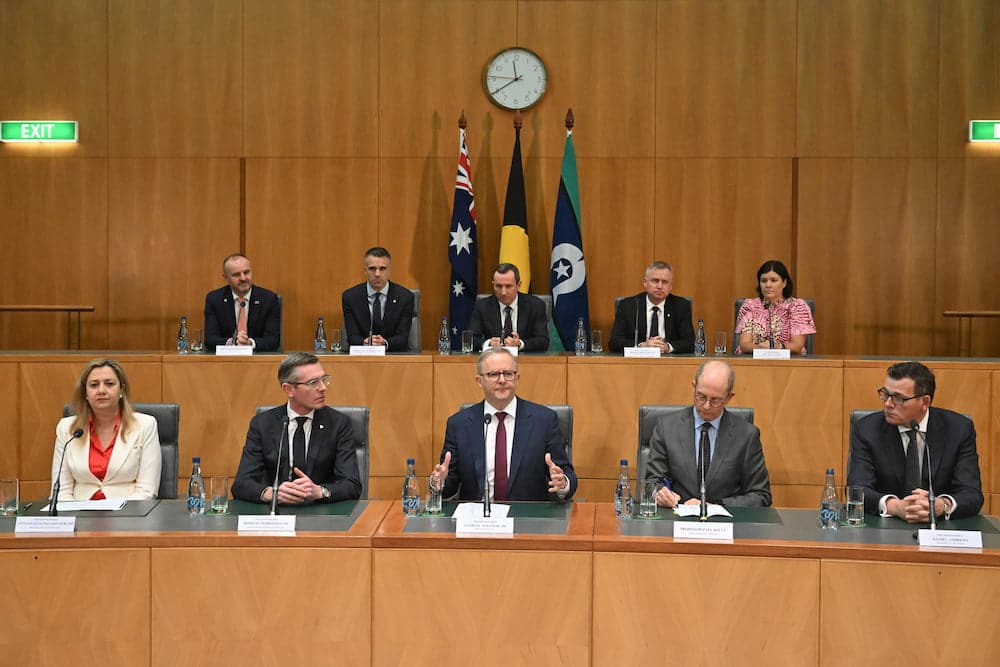Mandatory isolation periods for COVID-19 have been scrapped, following a unanimous decision by national cabinet.
Prime Minister Anthony Albanese and state and territory leaders agreed people with COVID-19 will no longer be subject to a five-day stay-at-home order, following Friday’s meeting at Parliament House.
The changes will come into effect from October 14.
The isolation period, however, will still apply to employees in vulnerable settings such as hospital workers and those in aged care.
The decision to eliminate the mandatory isolation period will also mean the end of pandemic leave payments for affected workers from October 14.
The payments that remain for workers in vulnerable settings would be split 50-50 between the Commonwealth and the states and territories.
Mr Albanese said the measures would be proportionate and would target the most vulnerable.
“We want a policy that promotes resilience and capacity-building and reduces a reliance on government intervention,” he told reporters in Canberra.
“It was a unanimous decision by the national cabinet today and had the support of all premiers and chief ministers.”
Chief medical officer Paul Kelly said while case numbers were low and the isolation requirement was easing, the pandemic was not over.
However, he said the emergency response phase of the virus had passed.
“We will almost certainly see future peaks of the virus … as we have seen earlier in this year,” he said.
“It is a time, though, now to consider that we have other things that we can do to protect those most vulnerable people and that is absolutely our key aim.”
Prof Kelly said removing isolation measures was reasonable.
“It is time to move away from COVID exceptionalism, in my view, and think about what we should do to protect people from any respiratory disease,” he said.
“We can’t look at isolation by itself. We need to look at those measures and the protections we have as well as other protections. It is important that we keep an option for a change to these settings in the future.”
The prime minister defended the decision to end the pandemic leave payments, saying it was the right time for the change.
“The flu has existed, and health issues have existed, for a long period of time, and the government hasn’t always stepped in to pay people’s wages while people have health concerns,” he said.
NSW Premier Dominic Perrottet said people sick with COVID-19 should still get tested and stay home.
“This is a day where we move to a more caring and compassionate approach where people look out for one another,” he said following national cabinet.
“We need to move to that approach and we need to just as we have with other infectious diseases in the past as well.”
The retail sector and the Australian Chamber of Commerce and Industry welcomed the decision to end isolation measures.
Chamber chief executive Andrew McKellar said the changes were common sense.
“Today, Australia has turned a corner in its approach to living with the virus,” he said.
“Importantly, these changes balance the relaxation of restrictions while also protecting the most vulnerable.”
Australian Retail Association chief executive Paul Zahra said the timing was right for the removal.
“Today’s decision will be a welcome relief for businesses who’ve been unable to trade at their full potential due to staff absence,” he said.
However earlier on Friday, Australian Medical Association president Steve Robson blasted leaders who advocated for the scrapping of isolation measures.
“People who are pushing for the isolation periods to be cut are not scientifically literate and are putting the public at risk and they need to understand that,” he told the ABC.
WEEKLY VIRUS DATA BY JURISDICTION
- ACT: 616 new cases, one death
- NSW: 12,592 new cases, 82 deaths
- Victoria: 9458 new cases, 59 deaths
- Queensland: 8061 new cases, 77 deaths
- WA: 4662 new cases, 10 deaths
- SA: 3104 new cases, 17 deaths
- NT: 339 new cases, two deaths



